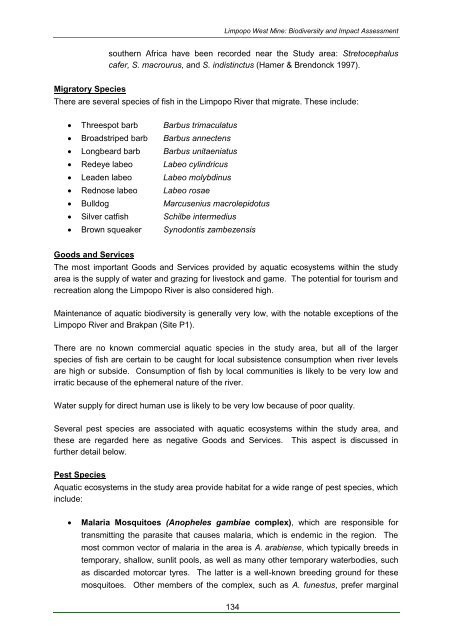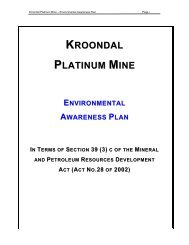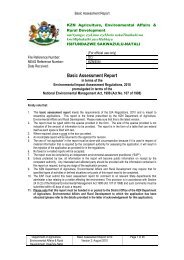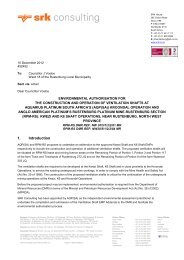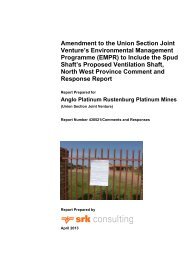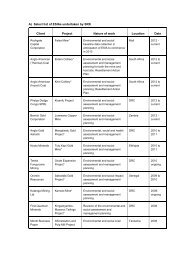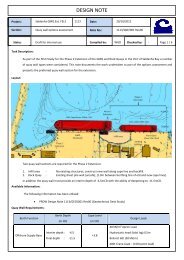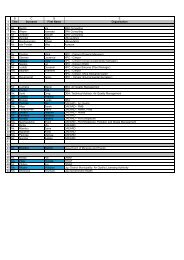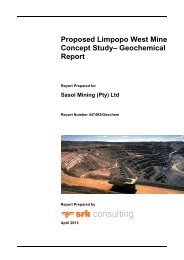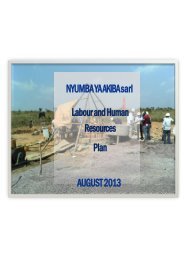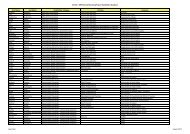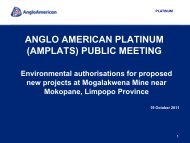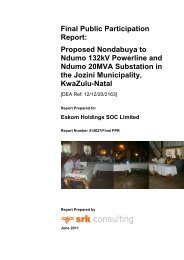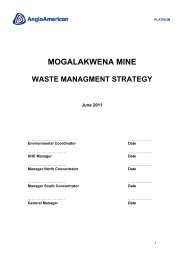- Page 3:
AcknowledgmentsIn addition to the E
- Page 6 and 7:
Remaining Natural Vegetation: Mediu
- Page 8 and 9:
Limpopo West Mine: Biodiversity and
- Page 10 and 11:
Limpopo West Mine: Biodiversity and
- Page 12 and 13:
Limpopo West Mine: Biodiversity and
- Page 14 and 15:
Limpopo West Mine: Biodiversity and
- Page 16 and 17:
Limpopo West Mine: Biodiversity and
- Page 18 and 19:
Limpopo West Mine: Biodiversity and
- Page 20 and 21:
Limpopo West Mine: Biodiversity and
- Page 22 and 23:
Limpopo West Mine: Biodiversity and
- Page 24 and 25:
Limpopo West Mine: Biodiversity and
- Page 26 and 27:
Limpopo West Mine: Biodiversity and
- Page 28 and 29:
Limpopo West Mine: Biodiversity and
- Page 30 and 31:
4.7. Wetland Protection and Sensiti
- Page 32 and 33:
Limpopo West Mine: Biodiversity and
- Page 34 and 35:
Limpopo West Mine: Biodiversity and
- Page 36 and 37:
Limpopo West Mine: Biodiversity and
- Page 38 and 39:
Limpopo West Mine: Biodiversity and
- Page 40 and 41:
Limpopo West Mine: Biodiversity and
- Page 42 and 43:
Limpopo West Mine: Biodiversity and
- Page 44 and 45:
Limpopo West Mine: Biodiversity and
- Page 46 and 47:
Limpopo West Mine: Biodiversity and
- Page 48 and 49:
Limpopo West Mine: Biodiversity and
- Page 50 and 51:
Limpopo West Mine: Biodiversity and
- Page 52 and 53:
Limpopo West Mine: Biodiversity and
- Page 54 and 55:
Limpopo West Mine - Biodiversity an
- Page 56 and 57:
6.1. Floral AssessmentLimpopo West
- Page 58 and 59:
Limpopo West Mine - Biodiversity an
- Page 60 and 61:
Limpopo West Mine - Biodiversity an
- Page 62 and 63:
Limpopo West Mine - Biodiversity an
- Page 64 and 65:
Limpopo West Mine - Biodiversity an
- Page 66 and 67:
Limpopo West Mine - Biodiversity an
- Page 68 and 69:
Limpopo West Mine - Biodiversity an
- Page 70 and 71:
Limpopo West Mine - Biodiversity an
- Page 72 and 73:
Limpopo West Mine - Biodiversity an
- Page 74 and 75:
Limpopo West Mine - Biodiversity an
- Page 76 and 77:
Limpopo West Mine - Biodiversity an
- Page 78 and 79:
Limpopo West Mine - Biodiversity an
- Page 80 and 81:
Limpopo West Mine: Biodiversity and
- Page 82 and 83:
Limpopo West Mine: Biodiversity and
- Page 84 and 85:
Limpopo West Mine: Biodiversity and
- Page 86 and 87:
Limpopo West Mine: Biodiversity and
- Page 88 and 89:
Table 7-5 Vegetation structure of P
- Page 90 and 91:
Limpopo West Mine: Biodiversity and
- Page 92 and 93:
Limpopo West Mine: Biodiversity and
- Page 94 and 95:
Limpopo West Mine: Biodiversity and
- Page 96 and 97:
Limpopo West Mine: Biodiversity and
- Page 98 and 99: Limpopo West Mine: Biodiversity and
- Page 100 and 101: Table 7-23BushLimpopo West Mine: Bi
- Page 102 and 103: Limpopo West Mine: Biodiversity and
- Page 104 and 105: Limpopo West Mine: Biodiversity and
- Page 106 and 107: 7.2.4. ReptilesLimpopo West Mine: B
- Page 108 and 109: Limpopo West Mine: Biodiversity and
- Page 110 and 111: Limpopo West Mine: Biodiversity and
- Page 112 and 113: Limpopo West Mine: Biodiversity and
- Page 114 and 115: Limpopo West Mine: Biodiversity and
- Page 116 and 117: Table 7-38Limpopo West Mine: Biodiv
- Page 118 and 119: 7.3.3. Description of Wetlands in t
- Page 120 and 121: Limpopo West Mine: Biodiversity and
- Page 122 and 123: Limpopo West Mine: Biodiversity and
- Page 124 and 125: Limpopo West Mine: Biodiversity and
- Page 126 and 127: Limpopo West Mine: Biodiversity and
- Page 128 and 129: 7.3.12. Wetland Site MN9Limpopo Wes
- Page 130 and 131: 7.3.14. Wetland Site MN11Limpopo We
- Page 132 and 133: Limpopo West Mine: Biodiversity and
- Page 134 and 135: Limpopo West Mine: Biodiversity and
- Page 136 and 137: Limpopo West Mine: Biodiversity and
- Page 138 and 139: Limpopo West Mine: Biodiversity and
- Page 140 and 141: Limpopo West Mine: Biodiversity and
- Page 142 and 143: Limpopo West Mine: Biodiversity and
- Page 144 and 145: Limpopo West Mine: Biodiversity and
- Page 146 and 147: Limpopo West Mine: Biodiversity and
- Page 150 and 151: Limpopo West Mine: Biodiversity and
- Page 152 and 153: Limpopo West Mine: Biodiversity and
- Page 154 and 155: Limpopo West Mine: Biodiversity and
- Page 156 and 157: Limpopo West Mine: Biodiversity and
- Page 158 and 159: Limpopo West Mine: Biodiversity and
- Page 160 and 161: Limpopo West Mine: Biodiversity and
- Page 162 and 163: Limpopo West Mine: Biodiversity and
- Page 164 and 165: Limpopo West Mine: Biodiversity and
- Page 166 and 167: Limpopo West Mine: Biodiversity and
- Page 168 and 169: Limpopo West Mine: Biodiversity and
- Page 170 and 171: Limpopo West Mine: Biodiversity and
- Page 172 and 173: Limpopo West Mine: Biodiversity and
- Page 174 and 175: Limpopo West Mine: Biodiversity and
- Page 176 and 177: Limpopo West Mine: Biodiversity and
- Page 178 and 179: Limpopo West Mine: Biodiversity and
- Page 180 and 181: Limpopo West Mine: Biodiversity and
- Page 182 and 183: Limpopo West Mine: Biodiversity and
- Page 184 and 185: Limpopo West Mine: Biodiversity and
- Page 186 and 187: Limpopo West Mine: Biodiversity and
- Page 188 and 189: Limpopo West Mine: Biodiversity and
- Page 190 and 191: 12.1. Floral AppendicesLimpopo West
- Page 192 and 193: CUCRBITACEAELimpopo West Mine: Biod
- Page 194 and 195: Limpopo West Mine: Biodiversity and
- Page 196 and 197: Limpopo West Mine: Biodiversity and
- Page 198 and 199:
Limpopo West Mine: Biodiversity and
- Page 200 and 201:
Limpopo West Mine: Biodiversity and
- Page 202 and 203:
Limpopo West Mine: Biodiversity and
- Page 204 and 205:
Limpopo West Mine: Biodiversity and
- Page 206 and 207:
Limpopo West Mine: Biodiversity and
- Page 208 and 209:
Limpopo West Mine: Biodiversity and
- Page 210 and 211:
Limpopo West Mine: Biodiversity and
- Page 212 and 213:
Limpopo West Mine: Biodiversity and
- Page 214 and 215:
Limpopo West Mine: Biodiversity and
- Page 216 and 217:
Limpopo West Mine: Biodiversity and
- Page 218 and 219:
Limpopo West Mine: Biodiversity and
- Page 220 and 221:
Limpopo West Mine: Biodiversity and
- Page 222 and 223:
Limpopo West Mine: Biodiversity and
- Page 224 and 225:
Limpopo West Mine: Biodiversity and


